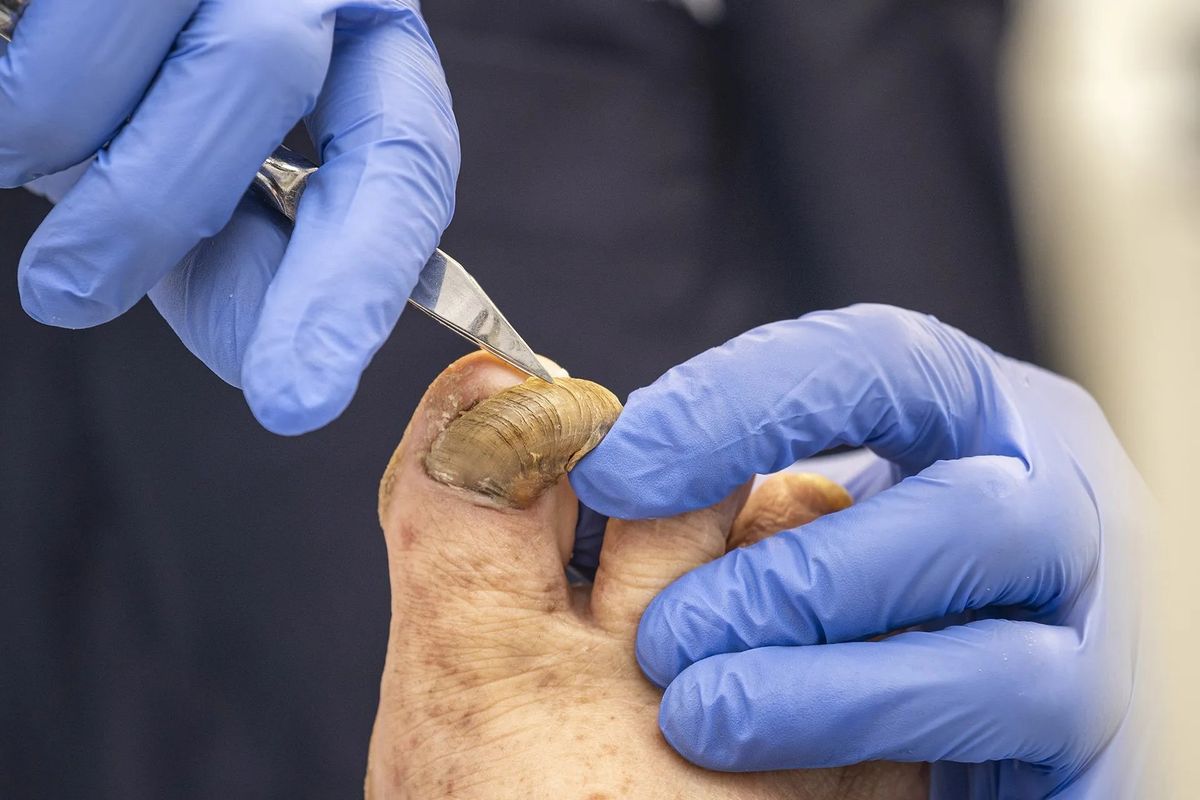
Onychogryphosis, often called "ram's horn nails," is a condition where nails become thick, curved, and claw-like. This nail disorder can affect both fingernails and toenails, but it's more common in the latter. Causes of onychogryphosis range from trauma and poor circulation to fungal infections and genetic factors. Symptoms include discolored, thickened nails that may cause discomfort or pain. Treatment typically involves trimming the nails, sometimes requiring professional help, and addressing underlying issues. Understanding onychogryphosis is crucial for maintaining nail health and preventing complications. Let's dive into 40 facts about this intriguing condition, shedding light on its causes, symptoms, and treatments.
Key Takeaways:
- Onychogryphosis, or "ram's horn nails," can cause pain and discomfort, affecting daily activities. It's important to seek professional treatment and maintain good nail hygiene to prevent and manage this condition.
- Onychogryphosis is not just a cosmetic issue; it can impact daily life and cause discomfort. Regular nail care, proper footwear, and professional treatment are essential for managing this condition.
What is Onychogryphosis?
Onychogryphosis, often called "ram's horn nails," is a condition where nails become thickened and curved. It's more common in toenails than fingernails. Let's dive into some intriguing facts about this condition.
-
Onychogryphosis is derived from Greek words "onycho" (nail) and "gryphosis" (curving).
-
This condition is often seen in elderly individuals due to reduced nail care and circulation.
-
Trauma to the nail or repeated injury can lead to onychogryphosis.
-
Fungal infections are a common cause, leading to thickened, discolored nails.
-
Poor foot hygiene can contribute to the development of this condition.
-
Genetic factors may play a role, making some people more prone to developing it.
Symptoms of Onychogryphosis
Recognizing the symptoms early can help in managing the condition better. Here are some signs to look out for:
-
Nails become thickened and discolored, often yellow or brown.
-
The nail may curve or twist, resembling a ram's horn.
-
Pain and discomfort are common, especially when wearing shoes.
-
Difficulty in trimming the nails due to their hardness and thickness.
-
Foul odor may be present if there is an underlying infection.
Causes of Onychogryphosis
Understanding the causes can help in preventing onychogryphosis. Here are some common causes:
-
Aging is a significant factor, as nails grow slower and thicker with age.
-
Injury to the nail bed can disrupt normal nail growth.
-
Poor circulation in the feet, often seen in diabetic patients, can lead to this condition.
-
Neglect in nail care, such as not trimming nails regularly, can cause onychogryphosis.
-
Wearing tight shoes can put pressure on the nails, leading to deformities.
Treatment Options
Treating onychogryphosis involves addressing the underlying cause and managing symptoms. Here are some treatment options:
-
Regular trimming by a healthcare professional can help manage the thickness.
-
Soaking the nails in warm water before trimming can soften them.
-
Topical antifungal treatments may be prescribed if a fungal infection is present.
-
Oral medications might be necessary for severe infections.
-
Surgical removal of the nail may be considered in extreme cases.
Prevention Tips
Preventing onychogryphosis involves maintaining good nail hygiene and care. Here are some tips:
-
Keep nails trimmed and clean to prevent thickening.
-
Wear comfortable shoes that do not put pressure on the nails.
-
Moisturize your feet regularly to prevent dryness and cracking.
-
Avoid trauma to the nails by being cautious during activities.
-
Regular check-ups with a podiatrist can help catch early signs.
Interesting Facts
Here are some lesser-known facts about onychogryphosis that might surprise you:
-
Onychogryphosis has been documented in ancient medical texts.
-
Animals like dogs and horses can also suffer from similar nail conditions.
-
Historical figures like King Louis XIV reportedly had onychogryphosis.
-
Nail salons often encounter mild cases and can provide basic care.
-
Home remedies like vinegar soaks are sometimes used, though not always effective.
Impact on Daily Life
Living with onychogryphosis can affect daily activities. Here are some ways it impacts life:
-
Walking can become painful due to thickened nails.
-
Wearing shoes might be uncomfortable, limiting footwear choices.
-
Self-esteem can be affected due to the appearance of the nails.
-
Daily hygiene routines may take longer due to the need for special care.
-
Social interactions might be impacted if the condition is severe.
Myths and Misconceptions
There are several myths surrounding onychogryphosis. Here are some common ones:
-
Myth: Only elderly people get onychogryphosis. Fact: It can affect younger individuals too.
-
Myth: It's just a cosmetic issue. Fact: It can cause significant pain and discomfort.
-
Myth: Home remedies can cure it. Fact: Professional treatment is often necessary.
-
Myth: It's contagious. Fact: Onychogryphosis itself is not contagious, though underlying infections might be.
Key Takeaways on Onychogryphosis
Onychogryphosis, often called ram's horn nails, is a condition where nails become thick and curved. It usually affects the elderly or those with poor foot care. Causes include trauma, neglect, and certain medical conditions like psoriasis or fungal infections. Symptoms are easy to spot: thick, yellow, and curved nails. Treatment involves regular trimming, proper hygiene, and sometimes medical intervention. Prevention is key—keep nails clean and trimmed, wear proper footwear, and seek medical advice if you notice changes. Living with onychogryphosis can be managed with the right care and attention. Knowing these facts helps you stay informed and proactive about nail health.
Frequently Asked Questions
Was this page helpful?
Our commitment to delivering trustworthy and engaging content is at the heart of what we do. Each fact on our site is contributed by real users like you, bringing a wealth of diverse insights and information. To ensure the highest standards of accuracy and reliability, our dedicated editors meticulously review each submission. This process guarantees that the facts we share are not only fascinating but also credible. Trust in our commitment to quality and authenticity as you explore and learn with us.
